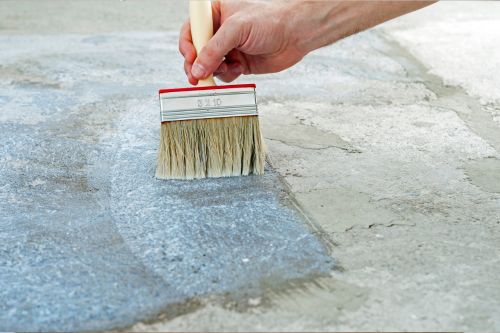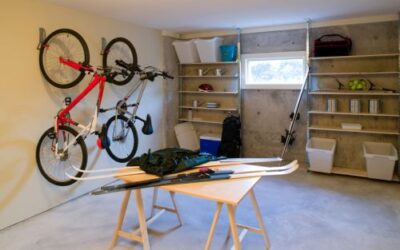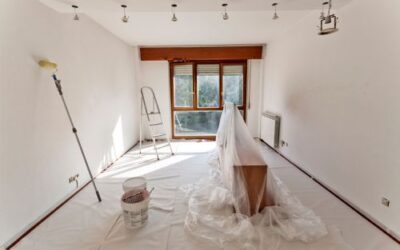Protecting an exterior floor – terrace, porch, garage or pedestrian access – is not just about aesthetics: it prevents cracks, leaks and premature wear and tear. Choosing the right exterior floor paint and applying it methodically ensures a durable and easy-to-maintain finish.
Contact our professionals
Choosing the right paint according to use and climate
Traffic and abrasion
-
Heavy (cars, motorbikes, forklifts) → two-component epoxy resins with high thickness.
-
Frequent pedestrian traffic → aliphatic polyurethane, flexible and UV stable.
-
Wet area or swimming pool → chlorinated rubber or anti-slip acrylic, compatible with chlorinated water.
Climate and exposure
-
Sunny and salty coasts require finishes with UV filters and high chemical resistance.
-
Cold areas require systems that cure below 10°C or accelerating additives.
Substrate type
-
New concrete (less than 30 days old) requires blocking primer.
-
Ceramic tile requires mechanical sanding or anchoring primer.
-
Self-levelling mortars accept almost any system, but a bond test is advisable.
For surfaces exposed to standing water, our terrace waterproofing service includes liquid membranes combined with anti-slip polyurethane varnishes.
Preparation of the substrate: 80% of success
Deep cleaning
Remove dust, grease and mould with a pressure washer and alkaline degreaser. Allow to dry for 24 hours.
Repairing and sealing
Fill cracks with epoxy mortar. In expansion joints apply elastic putty compatible with paint.
Moisture check
A damp floor causes blistering. Do not paint if the moisture content exceeds 5 % (CM meter).
Compatible primer
-
Waterborne acrylic on porous substrates.
-
Solvent or 100% solids epoxy for dense concrete.
-
Epoxy bonding bridge + aggregate if you are going to sprinkle quartz and create an anti-slip surface.
Application step by step
Mixing and standing
Stir base and catalyst until colour and viscosity are homogeneous. Respect the induction time indicated by the manufacturer.
First cross coat
Apply with microfibre roller to seal pores. Keep 0.25 l/m² for epoxy and 0.15 l/m² for acrylics.
Light sanding
After touch dry, sand lightly with 240 grit sandpaper. Remove dust with industrial hoover.
Finishing coat
Spread in the opposite direction to the previous one to obtain uniformity. Ensure relative humidity < 80 % and temperature > 10 °C.
Complete curing
Avoid pedestrian traffic for 24 h and road traffic for up to 72 h. Full chemical resistance is achieved after 7 days.
(Intervals may vary; always consult the product’s UNE-EN ISO 2813 data sheet).
Frequent mistakes that shorten the life of the floor covering
-
Painting on wet ground or without primer.
-
Omitting the exact proportion of catalyst in two-component systems.
-
Applying too thick coats: they crack when they expand with heat.
-
Do not respect recoating times and cause lack of adhesion between coats.
Maintenance and recoating
Sweep or vacuum sand and soil often; wash with neutral detergent and pressurised water once a week. After 3-4 years, a light sanding and a refreshing coat will restore shine and protection. If you detect flaking on skirtings or skirting boards, check the wall-solder joint; a leaking problem may require facade painters to fix it from the outside.
Technical note
For steel floors or external metal steps it is advisable to follow the environment classification of the UNE-EN ISO 12944 standard to ensure the correct corrosivity category.
Do you need professional help?
At Bartolomé Bas Pinturas we evaluate your floor in situ, choose the most suitable system and apply it with airless machinery and high performance rollers. Ask for a no obligation quote and enjoy a resistant, safe and aesthetic exterior floor year after year.
Other publications that may interest you
Paint suitable for basements and poorly ventilated rooms
Basements, storerooms or garages have unique conditions: poor ventilation, high humidity and increased risk of mould or condensation. Using conventional paint in these spaces is a common mistake that leads to ephemeral finishes and health problems due to fungi or...
How often should a house be painted depending on its use?
The frequency with which you should paint a house is not always the same. It depends on several factors: the use given to each room, the quality of the paint used, exposure to light or humidity, and even the colour. In this guide we explain how often you should renew...
Tips for painting a room without staining doors and sockets
Painting a room may seem like a simple task, but without the right preparation it's easy to end up with splashes on doors, sockets, switches and even skirting boards. If you want a clean, professional finish, we've got the best tips to avoid stains and save you...




